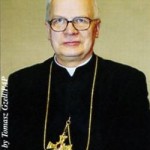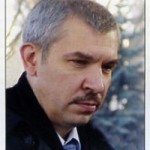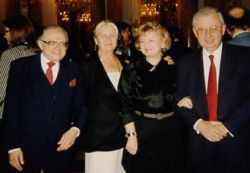20 kwiecień 2008
Who with whom? *
As a result of the Round Table meetings, which gathered both communists and the opposition, the first principles were established, but only partly free elections. They took place June 4, 1989. The majority of seats in the Sejm were taken by communists but 100 percent of the mandates in the Senate fell to the opposition. Tadeusz Mazowiecki was selected Prime Minister, a journalist and opposition activist. The office of President was reserved for General Wojciech Jaruzelski – the author and executor of Marshal Law on December 13, 1981. In 1990 the nation elected Lech Wałęsa (leader of Solidarity movement) chief of state. A two-chamber parliament (Sejm – 460 deputies and Senate – 100 senators) includes several functioning political parties.
We will present an attempt to interpret the Polish political scene. This does not mean, however, that we will bring understanding. Even Poles themselves struggle to understand these events, not to mention foreigners. In Poland over 100 political parties are registered.
If anyone has forgotten, let them be reminded that after the Second World War until 1989 Poland was ruled by communists under the shield of the United Polish Workers Party together with the “brotherly aid” of the Soviet Union.
As a result of the Round Table meetings, which gathered both communists and the opposition, the first principles were established, but only partly free elections. They took place June 4, 1989. The majority of seats in the Sejm were taken by communists but 100 percent of the mandates in the Senate fell to the opposition. Tadeusz Mazowiecki was selected Prime Minister, a journalist and opposition activist. The office of President was reserved for General Wojciech Jaruzelski – the auth
or and executor of Marshal Law on December 13, 1981. In 1990 the nation elected Lech Wałęsa chief of state.
Enough history – now for present day.
Until May 2004 political rule was held by the Social Democratic Alliance (post-communists) together with the Labor Union (UP). The Prime Minister was Leszek Miller. A two-chamber parliament (Sejm – 460 deputies and Senate – 100 senators) includes several functioning political parties.
- The Social Democratic Alliance (SLD) – has 162 deputies in the Sejm. The leader of SLD is Krzysztof Janik. In March of this year, Polish Social Democracy (SDPL), led by Marek Borowski, split from SLD. SLDP has 30 deputies and 5 senators.
- Citizens Platform (PO) – has 56 deputies in the Sejm. It is led by Donald Tusk (vice-speaker of the Sejm). This political grouping is center-right. Among well-known politicians in PO are: Jan Maria Rokita, Andrzej Olechowski and Zyta Gilowska.
Law and Justice (PiS) – has 42 deputies in the Sejm. It’s president is Jarosław Kaczyński. The party is Christian-democrat and conservative.
Polish Peasants’ Party (PSL) – has 37 deputies in the Sejm. It’s president is Janusz Wojciechowski. The grouping is peasant-oriented and center-left.
Samoobrona (Self-Defense) Party of the Republic of Poland – has 31 deputies in the Sejm. It’s leader is Andrzej Lepper. The party has an undefined ideology and is populist.
League of Polish Families – has 30 deputies in the Sejm. It is led by Marek Kotlinowski, but its „éminence grise” is Roman Giertych. This is a Christian-democratic and anti-European party.
Labor Union – has 15 Sejm deputies. It is led by Marek Pol and is a leftist grouping.
Additionally in the Sejm are minority party representatives: Peasants’ Democratic Party of Roman Jagieliński, Conservative Peasants’ Par
ty led by Artur Balazs, National Catholic Movement of Antoni Macierewicz and Polish Reconstruction Movement led by Jan Olszewski.
These parties have no Sejm representatives: Freedom Union of Władysław Frasyniuk and the Union of Real Politics led by Janusz
Korwin-Mikke.
The largest number of members are recorded by PSL – approx. 140 thousand, Samoobrona – approx. 100 thousand, SLD – approx. 80 thousand, PO – approx. 24 thousand.
Who’s Leading?
Election polls conducted in recent months indicate that the election battle will take place between the two strongest parties: Citizen’s Platform and Samoobrona. Both parties are changing in the rankings with from 20 to 26 percent support.
However, Samoobrona is pulling ahead in the polls. The party’s demagoguery and extreme populism is unsettling for the thinking members of society.
The Samoobrona Phenomenon **
Samoobrona, a grouping led by Andrzeja Leppera (the trade union and party exist separately), in recent weeks is gaining increasing support in public opinion polls (from 20 to 26 percent support; in the 2001 elections is achieved 10 percent of the vote).
Samoobrona was established in 1992. It is based on populist slogans, aggressive protest campaigns and accusations against politicians from all political parties who are supposedly guilty for poverty in the country. Lepper’s grouping advertises the fact that it has not yet ruled or taken part in a ruling coalition and – criticizing the sense of Polish economic reforms since 1989 – promotes its own program for fixing the state based on, among other things, large social expenditures from the budget, halting privatization, taxation of banks and use of the National Bank of Poland’s foreign exchange reserves. According to economists, realization of that plan would be catastrophe for state finances.
Nevertheless, Andrzej Lepper gains the support of the part of society that feels threatened by the principles of the free market and transformations in Poland, those who, at least subjectively, believe they have lost more than they have gained.
Lepper plays on nostalgia for Polish communism and longing for a welfare state as the opposite of a country where “everyone steals.”
Lepper has learned the principles of political marketing, influencing public opinion and creating his own positive image. He takes advice from advisors, travels throughout Poland and attracts more supporters.
In elections to the European Parliament the largest number of representatives may be deputies from Samoobrona and Citizen’s Platform.
Opinion poll
According to research by the Public Opinion Research Center (CBOS), as many as 72 percent of Poles express disapproval of the work of the Sejm and 48 percent of the Senate. Traditionally, President Aleksander Kwaśniewski was positively evaluated by 73 percent of those polled.
The police hold a stable position – trust in the police is expressed by 50 percent of those polled. However, Poles do not trust judges and prosecutors who earned 58 percent negative evaluations and only 21 percent positive opinions.
Two-thirds of Poles have a positive opinion of the Polish Army and only 9 percent hold a negative opinion of this institution. Attitudes toward the army are historic and stable.
* The issue was closed April 19, 2004.
** Polityka, issue 16, April 17, 2004.



























CATHOLIC CHURCH
Continuation and breakthrough
A little over 90% Poles declare themselves to be Catholic. However, 5% of believers do not attend church at all. 53,9% of believers declared they were living in accordance with the commandments of the Church. więcej...